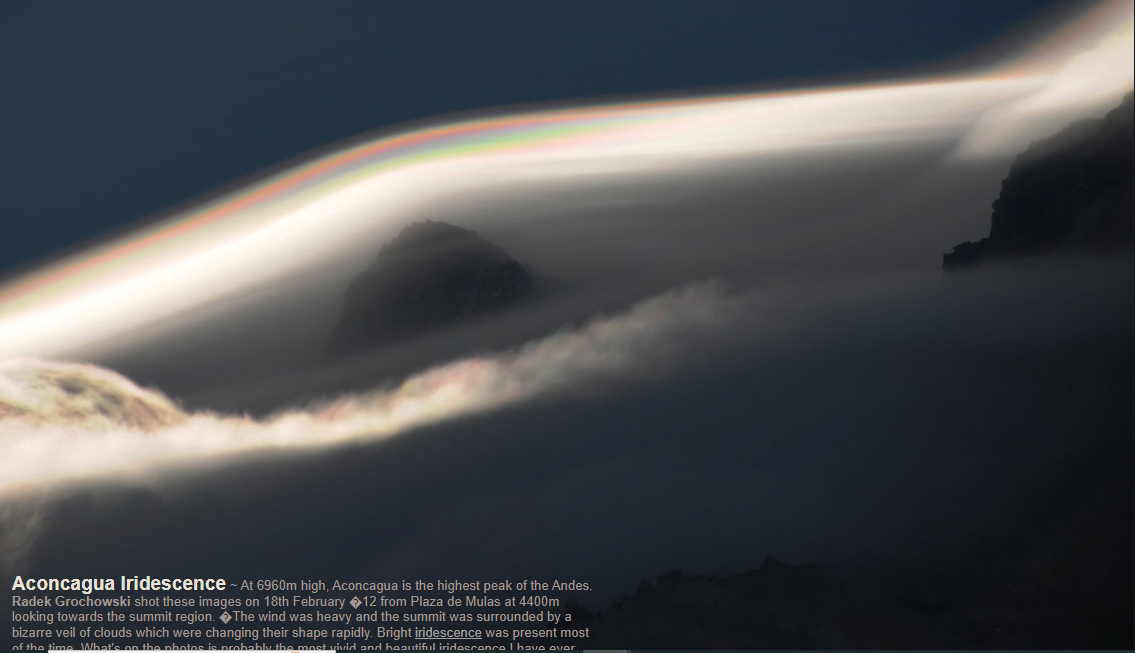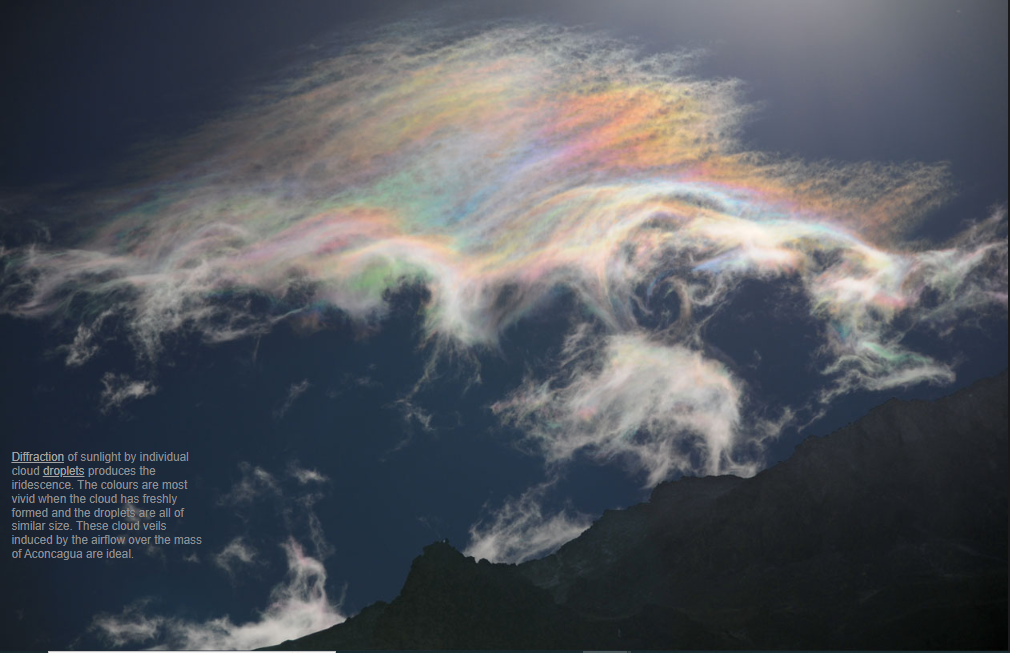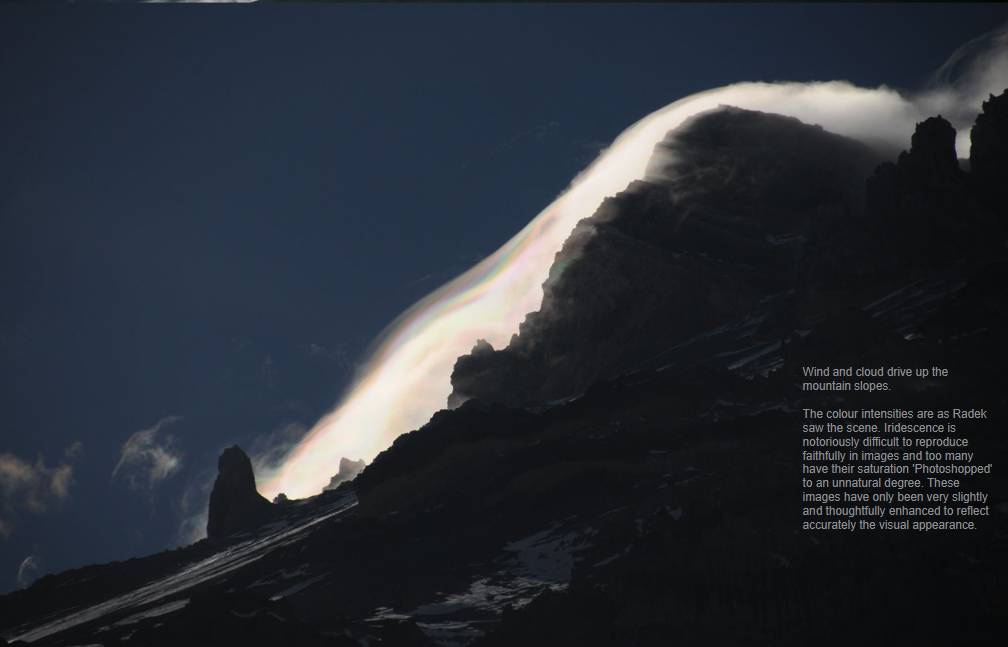OPOD - Aconcagua Iridescence
Aconcagua Iridescence: A Breathtaking Display of Atmospheric Optics
Located at a staggering height of 6960m, Aconcagua proudly stands as the highest peak in the Andes mountain range. On February 18th, Radek Grochowski captured a series of awe-inspiring images from Plaza de Mulas, situated at 4400m, with the summit region of Aconcagua as the backdrop. What he witnessed was a truly remarkable spectacle - a vibrant display of iridescence that left him in awe. In this blog post, we delve deeper into the phenomenon of Aconcagua iridescence, exploring its formation, characteristics, and the remarkable beauty it exhibits.
The Formation of Aconcagua Iridescence
The stunning colors of Aconcagua iridescence are a result of sunlight diffracting through individual cloud droplets. The most vivid hues are observed when the clouds have recently formed, and the droplets are of similar size. The cloud veils created by the airflow over the massive Aconcagua provide an ideal canvas for the display of this optical phenomenon.
Unveiling the Beauty
As Radek Grochowski's photographs illustrate, the iridescence on display at Aconcagua is truly breathtaking. The vibrant colors dance across the sky, creating a surreal atmosphere. It is important to note that capturing iridescence accurately in photographs is a challenge, as many images are often oversaturated or manipulated. However, Grochowski's images have been minimally enhanced to faithfully represent the visual appearance he witnessed.
Exploring the Mysteries
While Aconcagua iridescence is undeniably captivating, it also raises questions about the underlying atmospheric processes at play. The rapid changes in cloud shape and the heavy winds surrounding the summit add to the enigmatic nature of this phenomenon. Further research is needed to fully understand the intricate dynamics that give rise to such vivid and beautiful displays of iridescence.
A Symphony of Colors
The color intensities observed by Radek Grochowski accurately depict the scene he experienced. The iridescence at Aconcagua showcases a remarkable range of colors, from vibrant blues and purples to fiery oranges and pinks. Each hue blends seamlessly into the next, creating a harmonious symphony of colors that captivate the observer.
The Magic of Iridescence
Iridescence is a captivating optical phenomenon that has fascinated scientists and artists alike for centuries. It occurs when light waves interact with small particles or structures, resulting in the separation and interference of different wavelengths. This interference produces the vivid colors observed in iridescent displays, such as those witnessed at Aconcagua.
A Natural Masterpiece
Aconcagua iridescence stands as a testament to the awe-inspiring beauty found in nature. The combination of atmospheric conditions, wind patterns, and cloud formations create a canvas on which the colors of the spectrum come alive. The ever-changing shape of the clouds and the interplay between light and droplets transform Aconcagua into a natural masterpiece that leaves viewers spellbound.
Seeking Inspiration
The captivating iridescence observed at Aconcagua serves as a source of inspiration for photographers, artists, and nature enthusiasts. The unique blend of colors and the ethereal quality of the display provide endless creative possibilities. It encourages individuals to explore the world around them, capturing the magic of atmospheric optics and sharing it with others.
A Window into Nature's Wonders
Aconcagua iridescence offers a glimpse into the intricate workings of our atmosphere and the mesmerizing phenomena it can produce. It reminds us of the hidden beauty that surrounds us, waiting to be discovered and appreciated. By studying and documenting these natural wonders, we deepen our understanding of the world and foster a deeper connection with the environment.
Embracing the Mysteries
While we may never fully unravel all the mysteries of Aconcagua iridescence, its allure lies in its ability to captivate and inspire. It invites us to embrace the unknown, to marvel at the wonders of nature, and to recognize the boundless beauty that exists in even the most remote corners of our planet. Aconcagua iridescence serves as a reminder that there is always more to discover and appreciate in the world around us.

Aconcagua Iridescence ~ At 6960m high, Aconcagua is the highest peak of the Andes. Radek Grochowski shot these images on 18th February �12 from Plaza de Mulas at 4400m looking towards the summit region. �The wind was heavy and the summit was surrounded by a bizarre veil of clouds which were changing their shape rapidly. Bright iridescence was present most of the time. What's on the photos is probably the most vivid and beautiful iridescence I have ever seen. Nikon D300 and Nikkor 18-200 lens.� Images ©Radek Grochowski, shown with permission

Diffraction of sunlight by individual cloud droplets produces the iridescence. The colours are most vivid when the cloud has freshly formed and the droplets are all of similar size. These cloud veils induced by the airflow over the mass of Aconcagua are ideal.

Wind and cloud drive up the mountain slopes.
The colour intensities are as Radek saw the scene. Iridescence is notoriously difficult to reproduce faithfully in images and too many have their saturation 'Photoshopped' to an unnatural degree. These images have only been very slightly and thoughtfully enhanced to reflect accurately the visual appearance.
Note: this article has been automatically converted from the old site and may not appear as intended. You can find the original article here.
Reference Atmospheric Optics
If you use any of the definitions, information, or data presented on Atmospheric Optics, please copy the link or reference below to properly credit us as the reference source. Thank you!
-
<a href="https://atoptics.co.uk/blog/opod-aconcagua-iridescence/">OPOD - Aconcagua Iridescence</a>
-
"OPOD - Aconcagua Iridescence". Atmospheric Optics. Accessed on November 26, 2024. https://atoptics.co.uk/blog/opod-aconcagua-iridescence/.
-
"OPOD - Aconcagua Iridescence". Atmospheric Optics, https://atoptics.co.uk/blog/opod-aconcagua-iridescence/. Accessed 26 November, 2024
-
OPOD - Aconcagua Iridescence. Atmospheric Optics. Retrieved from https://atoptics.co.uk/blog/opod-aconcagua-iridescence/.